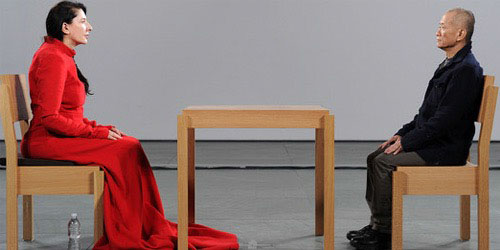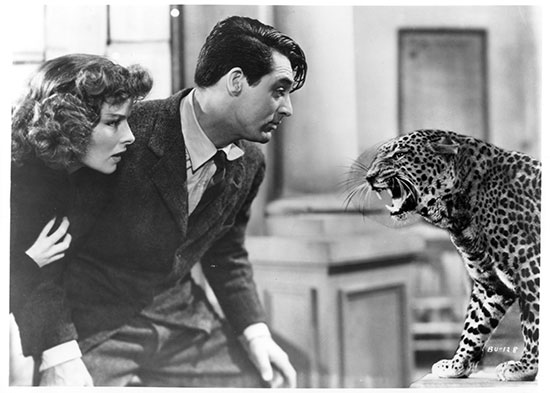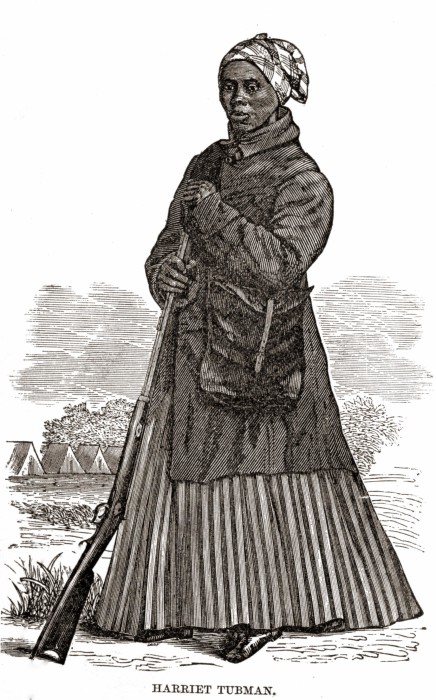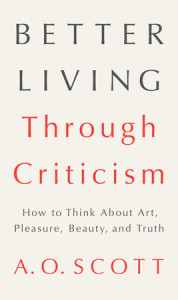“Don’t pay any attention to the critics, don’t even ignore ’em,” bellowed Jerry Lewis to an interviewer who suggested that his slapstick antics with straight man Dean Martin resembled mimicry of a muscular dystrophy sufferer.
This was a jarring punch, as Lewis had raised charity funds with his big top Muscular Dystrophy (MD) telethons going back to 1950s. Nonetheless, soon after the interview, Lewis’s spastic shtick would disappear. It was now impossible to watch his old routine without comparing it to MD and wondering if that was the source material.
Such is the life of a critic: noticing the loose cord on a tent stake and giving it a good yank. More often than not the entire tent collapses.
Writer A. O. Scott, who is both magnanimous and self-deprecating about his role as a chief film critic at The New York Times, has written a witty, erudite, and often hilarious book on his odd trade, “Better Living Through Criticism: How to Think About Art, Pleasure, Beauty, and Truth” (Published Penguin Press, 2016, 288 pp).
The book consists of six chapters and four dialogues in which criticism itself is modeled in myriad ways, mostly benevolently. E.L. Doctorow once chuckled that writing was “talking to oneself.” Scott ups the game with his dialogs, which are actually auto-interviews. This unique literary form is like playing chess with oneself, with the thought process of the thinker laid bare in a Proustian reflection full of humor and acumen.
“Q. So you’ve written a book in defense of thinking? Where’s the argument? Nobody is really against thinking.
A. Are you serious? Anti-intellectualism is virtually our civic religion….”
And so on.
The author has a real command of the history of letters and cites multiple centuries of wit and pith on every page, making this tome somewhat unnerving for those of us who scribble for a living. How did this guy get so smart?
Scott initially makes the case that the critic and the artist are in the same boat rowing together, and offers that the act of art is in itself an act of criticism on what has come before. This is an idea with merit, and one he develops in his essay “The Critic as Artist and Vice Versa.” Scott motors directly into our hyper-relativist times pointing out that even a child knows that some finger paintings are good enough to end up on the refrigerator door and most are not. The observation of quality appears early in one’s life.
Quickly he dispenses with the routine angry response critics receive that they are just failed artists, noting that the poet Charles Baudelaire, composer Hector Berlioz, dramatist George Bernard Shaw, and artist and architect Le Corbusier all wrote criticism as well as being masters in their respective trades.
Unfortunately, in this critic’s view, Scott wastes his considerable talent on an effusive chapter discussing the popular silliness The Artist is Present, better known by me as a Brooklyn Staring Contest, held at the Museum of Modern Art. In this piece, Serbian performance artist Marina Abramović sat across from an endless line of fragile souls and, well, stared at them.
Those who queued up for this silent tête-à-tête would probably weep at the sight of a wet kitten, yet Scott fetishizes their emotional outpouring, in my opinion, likening it to poems of Rilke and the eyeless statue of Apollo. Oh, boy.
And so it goes in the world of criticism: opinions vary, often widely.
.

“The Artist is Present” by Marina Abramović at Museum of Modern Art, March 14–May 31, 2010.
.
Scott is more on his game, in my opinion, in the lengthy essay “Lost in the Museum,” which deftly examines the culture wars against The Dead White Male and the Eurocentric domination of “taste” by works regarded as excellent. This identity politics balkanization of inherited culture, launched as a campaign in the 1990s, he nails as a “loud dialog of the deaf.”
For those who claim they are simply responding, often bitterly, to exclusion, he offers the balm that the cultural canon is forever being renegotiated to make it more inclusive, and the current rancor in academia is more the norm than anyone cares to admit.
It is a singular experience to study and thereafter construct a criticism of a book that is critiquing us back-seat drivers, i.e. critics, as we type. In his important chapter “How to Be Wrong,” he waves off reviewers landing on a safe list of modifiers that unfortunately reads like the Approved Words list of most art rags:
“The first habit of highly ineffective critics is the promiscuous hurling of adjectives … Astonishing Beautiful Deadly Execrable Flabbergasting Gorgeous Horrifying Inimitable Jaw-Dropping Kicky Laughable Mesmerizing Nugatory Overpowering Painful Quirky Riotous Stunning Terrific Unforgettable Vexing Wondrous Yummy …These are all just synonyms for “good” and “bad” and like those bland childish words they push a writer off the stony slopes of argument and into the clammy bogs of assertion.”
Instead Scott argues critics should realize that they are part of a system that probably is wrong, will almost certainly be regarded as wrong if it is healthy, and the cards are reshuffled every generation or so. Praise is somewhat useless, as is abrupt dismissal, and Scott lists works of art that were at one time universally ridiculed, such as Melville’s “Moby Dick,” the Howard Hawks film “Bringing Up Baby,” and the entire catalog of French modernism, beginning with the impressionists.
“Bringing Up Baby” turns out to be one of Scott’s favorite films, and he favors readers with his extensive knowledge of its place in history.
.

Fr. “Bringing Up Baby,” Cary Grant and Audrey Hepburn with the pet leopard.
.
He further discusses and illuminates the classic uses of formalism and other approaches critics use to set about handicapping artworks, which will ultimately be sorted in a Darwinian fashion by dynamics entirely beyond their grasp, or anyone else’s. What critics can do in the meantime until they are ultimately proved or deemed wrong is to broaden the understanding and depth of a worthy artwork.
Consider two reviews of the same event: a hypothetical change of the artwork on one side of the $20 bill using an image of Harriet Tubman holding a rifle.
One reviewer might suggest that “the Republican-controlled Congress unceremoniously removed the founder of the Democratic Party from the front of the $20 bill and replaced him with a Republican war hero and devout Christian who routinely poses with her rifle.” Another might say that “a black abolitionist named Harriet Tubman will replace the white slave-owning Andrew Jackson on the front of the $20 bill.”
Which take will ultimately be judged “wrong”? Probably both, if one adheres to A.O. Scott’s argument. But both of these reviews can still be seen as attempting to broaden understanding and offer perspective on the event. In the meantime, new dimensions will continue to come to light that no doubt played into the various selfish interests that allowed for agreement on the change and what image was chosen. Better living through criticism indeed.

A woodcut by an unknown artist published in "Scenes in the Life of Harriet Tubman"; W.J. Moses, printer; stereotyped by Dennis Bro's & Co.
_________________________________
BASIC FACTS: "Better Living Through Criticism: How to Think About Art, Pleasure, Beauty, and Truth" by A.O. Scott is published by New York: Penguin Press, 2016.
_________________________________
Copyright 2016 Hamptons Art Hub LLC. All rights reserved.

